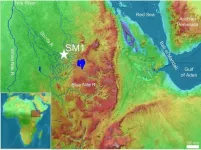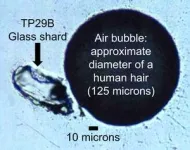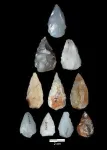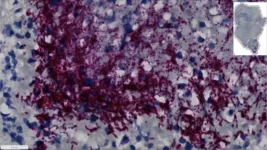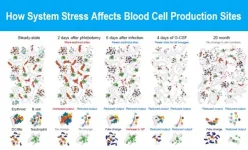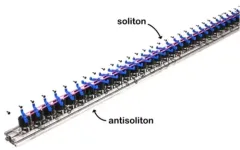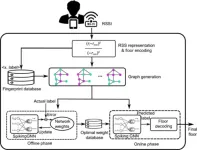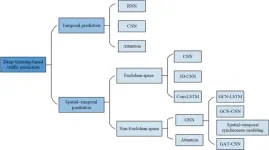(Press-News.org) Modern humans dispersed from Africa multiple times, but the event that led to global expansion occurred less than 100,000 years ago. Some researchers hypothesize that dispersals were restricted to “green corridors” formed during humid intervals when food was abundant and human populations expanded in lockstep with their environments. But a new study in Nature, including ASU researchers Curtis Marean, Christopher Campisano, and Jayde Hirniak, suggests that humans also may have dispersed during arid intervals along “blue highways” created by seasonal rivers. Researchers also found evidence of cooking and stone tools that represent the oldest evidence of archery.
Working in the Horn of Africa, researchers have uncovered evidence showing how early modern humans survived in the wake of the eruption of Toba, one of the largest supervolcanoes in history, some 74,000 years ago. The behavioral flexibility of these people not only helped them live through the supereruption but may have facilitated the later dispersal of modern humans out of Africa and across the rest of the world.
“This study confirms the results from Pinnacle Point in South Africa – the eruption of Toba may have changed the environment in Africa, but people adapted and survived that eruption-caused environmental change,” said Marean, research scientist with the Institute of Human Origins and Foundation Professor with the School of Human Evolution and Social Change.
The team investigated the Shinfa-Metema 1 site in the lowlands of present-day northwestern Ethiopia along the Shinfa River, a tributary of the Blue Nile River.
The supereruption occurred during the middle of the time when the site was occupied and is documented by tiny glass shards whose chemistry matches that of Toba.
Pinpoint timing through cryptotephra
“One of the ground-breaking implications of this study,” said Marean, “is that with the new cryptotephra methods developed for our prior study in South Africa, and now applied here to Ethiopia, we can correlate sites across Africa, and perhaps the world, at a resolution of several weeks of time.”
Cryptotephra are signature volcanic glass shards that can range from 80–20 microns in size, which is smaller than the diameter of a human hair. To extract these microscopic shards from archaeological sediment requires patience and great attention to detail.
“Searching for cryptotephra at these archaeological sites is like looking for a needle in a haystack, but not knowing if there is even a needle. However, having the ability to correlate sites 5,000 miles apart, and potentially further, to within weeks instead of thousands of years makes it all worth it,” said Christopher Campisano, research scientist with the Institute of Human Origins and professor with the School of Human Evolution and Social Change.
“This study, once again,” said Campisano, “highlights the importance of the University of Nevada-Las Vegas/Arizona State University team pushing the limits for successfully analyzing extremely low abundance cryptotephra to date and correlate archaeological sites across Africa.”
The methods for identifying low abundance cryptotephra at Pinnacle Point were first developed at University of Nevada Las Vegas led by the late Gene Smith and Racheal Johnsen and now carried on at Arizona State University’s Sediment and TEphra Preparation (STEP) Lab.
School of Human Evolution and Social Change graduate student Jayde Hirniak led ASU’s effort to create its own cryptotephra lab—the STEP Lab—working with Campisano and building on methods developed at UNLV. Hirniak also collaborated with cryptotephra labs in the United Kingdom that work with sediment samples preserving hundreds or thousands of glass shards. Now Hirniak’s primary expertise is in tephrochronology, which involves the use of volcanic ash to link archaeological and paleoenvironmental records and place them on the same timeline, which was her contribution to this research.
“Our lab at ASU was built to process extremely low abundance cryptotephra horizons (<10 shards per gram) using a highly specialized technique. There are only a few labs in the world with these capabilities,” said Hirniak.
Migrations along “blue highways”
Based on isotope geochemistry of the teeth of fossil mammals and ostrich eggshells, they concluded that the site was occupied by humans during a time with long dry seasons on a par with some of the most seasonally arid habitats in East Africa today. Additional findings suggest that when river flows stopped during dry periods, people adapted by hunting animals that came to the remaining waterholes to drink. As waterholes continued to shrink, it became easier to capture fish without any special equipment, and diets shifted more heavily to fish.
Its climatic effects appear to have produced a longer dry season, causing people in the area to rely even more on fish. The shrinking of the waterholes may also have pushed humans to migrate outward in search of more food.
“As people depleted food in and around a given dry season waterhole, they were likely forced to move to new waterholes,” said John Kappelman, a UT anthropology and earth and planetary sciences professor and lead author of the study. “Seasonal rivers thus functioned as ‘pumps’ that siphoned populations out along the channels from one waterhole to another, potentially driving the most recent out-of-Africa dispersal.
The humans who lived at Shinfa-Metema 1 are unlikely to have been members of the group that left Africa. However, the behavioral flexibility that helped them adapt to challenging climatic conditions such as the Toba supereruption was probably a key trait of Middle Stone Age humans that allowed our species to ultimately disperse from Africa and expand across the globe.
The people living in the Shinfa-Metema 1 site hunted a variety of terrestrial animals, from antelope to monkey, as attested to by cut marks on the bones, and apparently cooked their meals as shown by evidence of controlled fire at the site. The most distinctive stone tools are small, symmetrical triangular points. Analyses show that the points are most likely arrowheads that, at 74,000 years in age, represent the oldest evidence of archery.
ASU’s cryptotephra research was funded by the Hyde Family Foundations, the National Science Foundation, the Institute of Human Origins, and Arizona State University.
###
Media Contact
Julie Russ
jruss@asu.edu
END
Toba supereruption unveils new insights into early human migration
Supereruption but may have facilitated the dispersal of modern humans out of Africa and across the rest of the world.
2024-03-20
ELSE PRESS RELEASES FROM THIS DATE:
Bacteria subtype linked to growth in up to 50% of human colorectal cancers, Fred Hutch researchers report
2024-03-20
Researchers at Fred Hutchinson Cancer Center have found that a specific subtype of a microbe commonly found in the mouth is able to travel to the gut and grow within colorectal cancer tumors. This microbe is also a culprit for driving cancer progression and leads to poorer patient outcomes after cancer treatment.
The findings, published March 20 in the journal Nature, could help improve therapeutic approaches and early screening methods for colorectal cancer, which is the second most common cause of cancer deaths in adults in the U.S. according to the American Cancer Society.
Examining colorectal cancer tumors removed from ...
Reducing the side effects of breast and ovarian cancer treatment
2024-03-20
Some anti-cancer treatments not only target tumour cells but also healthy cells. If their effects on the latter are too strong, their use can become limiting. A team from the University of Geneva (UNIGE), in collaboration with Basel-based FoRx Therapeutics, has identified the mechanism of action of PARP inhibitors, used in particular for breast and ovarian cancer in patients carrying the BRCA gene mutation. These inhibitors block two specific activities of the PARP proteins. By blocking one of them, the toxic effect on cancer cells is maintained, while healthy cells are preserved. This work, published in the journal Nature, will help improve the efficacy of these treatments.
Despite ...
Skeleton-wide study of blood cell formation yields surprising findings
2024-03-20
Imagine being able to count the different types of blood cells being formed inside the tiny bones of a mouse and pinpointing the strings and clusters of cells within the bone marrow that are responsible for producing specific types of blood cells.
That’s exactly what a team of scientists led by experts at Cincinnati Children’s achieved in a far-reaching study published March 20, 2024, in the prestigious journal Nature. Their work adds unprecedented new understanding of the “elegant” and “resilient” anatomy of bone marrow while also generating evidence of unexpected variations in how the skeleton ...
MD Anderson Research Highlights for March 20, 2024
2024-03-20
HOUSTON ― The University of Texas MD Anderson Cancer Center’s Research Highlights showcases the latest breakthroughs in cancer care, research and prevention. These advances are made possible through seamless collaboration between MD Anderson’s world-leading clinicians and scientists, bringing discoveries from the lab to the clinic and back.
Recent developments at MD Anderson offer insights into a combination therapy that slows pancreatic cancer progression, an all-oral treatment for older patients with acute myeloid leukemia (AML) unable to receive intensive chemotherapy, novel targets to protect against osteoporosis and bone metastasis, the generation ...
An endless domino effect
2024-03-20
If it walks like a particle, and talks like a particle… it may still not be a particle. A topological soliton is a special type of wave or dislocation which behaves like a particle: it can move around but cannot spread out and disappear like you would expect from, say, a ripple on the surface of a pond. In a new study published in Nature, researchers from the University of Amsterdam demonstrate the atypical behaviour of topological solitons in a robotic metamaterial, something which in the future may be used to control how robots move, sense their surroundings and communicate.
Topological solitons can be found in many ...
ARPA-H appoints Etta Pisano to lead its Advancing Clinical Trials Readiness Initiative
2024-03-20
The Advanced Research Projects Agency for Health (ARPA-H) has appointed Etta D. Pisano, MD, FACR, senior portfolio lead, to build the agency's clinical trial portfolio and lead the ARPA-H Advancing Clinical Trials Readiness Initiative under ARPA-H Resilient Systems Mission Office Director Jennifer Roberts.
The first radiologist to be appointed to such a role, Dr. Pisano is an internationally recognized expert in women's health, breast cancer research, and the use of artificial intelligence in ...
Quantum tornado provides gateway to understanding black holes
2024-03-20
Scientists have for the first time created a giant quantum vortex to mimic a black hole in superfluid helium that has allowed them to see in greater detail how analogue black holes behave and interact with their surroundings.
Research led by the University of Nottingham, in collaboration with King’s College London and Newcastle University, have created a novel experimental platform: a quantum tornado. They have created a giant swirling vortex within superfluid helium that is chilled to the lowest possible temperatures. Through the observation of minute wave dynamics on the superfluid’s surface, the research team has shown that these quantum ...
Introducing Floorlocator: a game-changer in indoor navigation technology
2024-03-20
Researchers have developed FloorLocator, a breakthrough in indoor navigation technology, which combines the high efficiency of Spiking Neural Networks (SNNs) with the advanced learning capabilities of Graph Neural Networks (GNNs). This innovative approach ensures remarkable accuracy and scalability for floor localization, crucial for enhancing emergency responses, indoor positioning, and personalized recommendation systems.
Indoor positioning is transforming with applications demanding precise location tracking. Traditional methods, including fingerprinting and sensor-based techniques, though widely used, face significant drawbacks such as the ...
New survey on deep learning solutions for cellular traffic prediction
2024-03-20
The bustling streets of a modern city are filled with countless individuals using their smartphones for streaming videos, sending messages and browsing the web. In the era of rapidly expanding 5G networks and the omnipresence of mobile devices, the management of cellular traffic has become increasingly complex. To address this challenge, mobile network operators need methods for the accurate prediction of cellular traffic. A comprehensive survey published 5 Jan. in Intelligent Computing explores deep learning techniques for cellular traffic prediction.
Better cellular traffic prediction would enhance intelligent 5G network construction and resource management, thereby ...
Cellular architecture of lesions in MS now mapped out
2024-03-20
Using advanced methodology, scientists in Sweden were able to reveal at the cellular level how lesions in multiple sclerosis develop. The new results are presented in the journal Cell by researchers from Karolinska Institutet and Stockholm University.
Over 1,8 million people worldwide are diagnosed with multiple sclerosis, MS. In this disease, the body's immune cells attack the cells that form myelin, the so-called oligodendrocytes, which belong to the group of glial cells. Without myelin, signals between nerve cells cannot travel as fast as ...
LAST 30 PRESS RELEASES:
Tracing the quick synthesis of an industrially important catalyst
New software sheds light on cancer’s hidden genetic networks
UT Health San Antonio awarded $3 million in CPRIT grants to bolster cancer research and prevention efforts in South Texas
Third symposium spotlights global challenge of new contaminants in China’s fight against pollution
From straw to soil harmony: International team reveals how biochar supercharges carbon-smart farming
Myeloma: How AI is redrawing the map of cancer care
Manhattan E. Charurat, Ph.D., MHS invested as the Homer and Martha Gudelsky Distinguished Professor in Medicine at the University of Maryland School of Medicine
Insilico Medicine’s Pharma.AI Q4 Winter Launch Recap: Revolutionizing drug discovery with cutting-edge AI innovations, accelerating the path to pharmaceutical superintelligence
Nanoplastics have diet-dependent impacts on digestive system health
Brain neuron death occurs throughout life and increases with age, a natural human protein drug may halt neuron death in Alzheimer’s disease
SPIE and CLP announce the recipients of the 2025 Advanced Photonics Young Innovator Award
Lessons from the Caldor Fire’s Christmas Valley ‘Miracle’
Ant societies rose by trading individual protection for collective power
Research reveals how ancient viral DNA shapes early embryonic development
A molecular gatekeeper that controls protein synthesis
New ‘cloaking device’ concept to shield sensitive tech from magnetic fields
Researchers show impact of mountain building and climate change on alpine biodiversity
Study models the transition from Neanderthals to modern humans in Europe
University of Phoenix College of Doctoral Studies releases white paper on AI-driven skilling to reduce burnout and restore worker autonomy
AIs fail at the game of visual “telephone”
The levers for a sustainable food system
Potential changes in US homelessness by ending federal support for housing first programs
Vulnerability of large language models to prompt injection when providing medical advice
Researchers develop new system for high-energy-density, long-life, multi-electron transfer bromine-based flow batteries
Ending federal support for housing first programs could increase U.S. homelessness by 5% in one year, new JAMA study finds
New research uncovers molecular ‘safety switch’ shielding cancers from immune attack
Bacteria resisting viral infection can still sink carbon to ocean floor
Younger biological age may increase depression risk in older women during COVID-19
Bharat Innovates 2026 National Basecamp Showcases India’s Most Promising Deep-Tech Ventures
Here’s what determines whether your income level rises or falls
[Press-News.org] Toba supereruption unveils new insights into early human migrationSupereruption but may have facilitated the dispersal of modern humans out of Africa and across the rest of the world.
